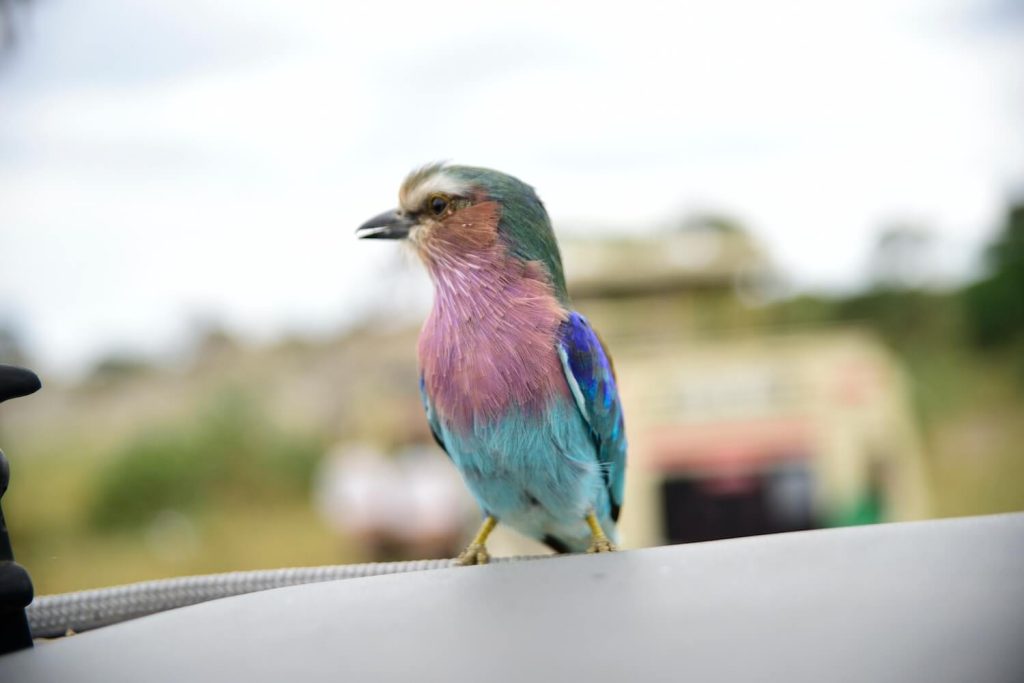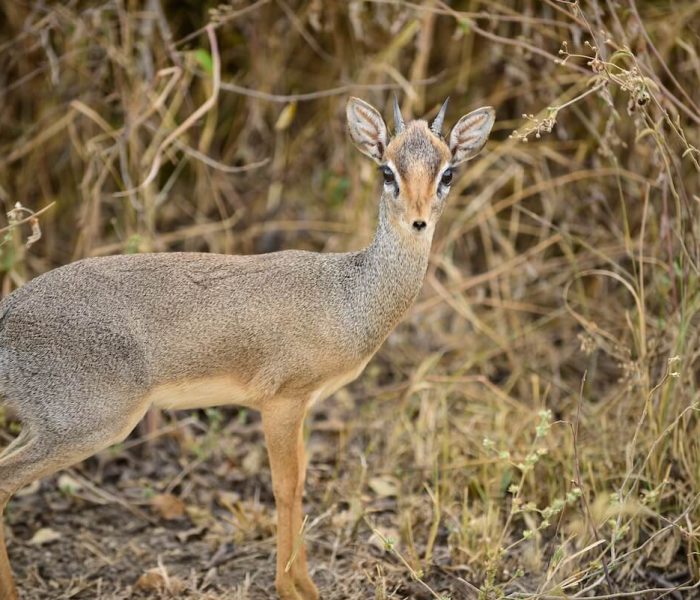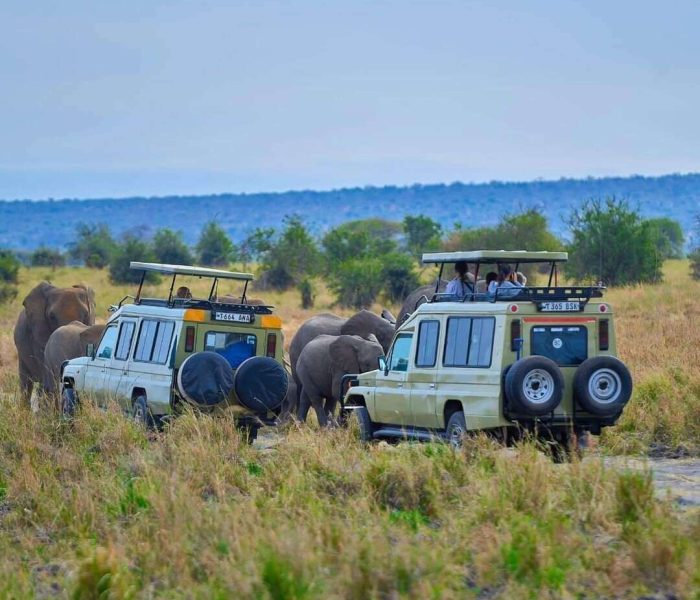The Ngorongoro Conservation Area, a UNESCO World Heritage Site since 1979, is known for its rich and varied landscapes, featuring mountain forests, woodlands, grasslands, lakes, and swamps. It’s home to vital archaeological sites, like Oldupai Gorge and Laetoli, where evidence of early human habitation dates back over 3 million years.
Size
2,850 sq km (1,100 sq miles)
Established
1970
Distance from Arusha
118 km (73 miles)

Nestled in northern Tanzania, Tarangire National Park is a stunning wildlife haven, easily accessible from Arusha or Moshi. It’s a fantastic starting point before exploring the renowned Ngorongoro Crater or the Serengeti. The park boasts a thriving array of wildlife, featuring both resident species and seasonal migrators. Among its most iconic inhabitants are large herds of elephants, elegant giraffes, swift impalas, and various species of antelope, alongside warthogs, zebras, and wildebeests.
The park is particularly famous for its striking baobab trees, which rise majestically above the savannah. These ancient giants not only enhance the park’s scenic beauty but also provide essential habitats for various animals, including bees, birds, and bats, while offering fruit and indirect water sources during dry spells.
From June to September, Tarangire experiences a mini-migration, drawing thousands of wildebeests and zebras seeking lush grazing. This influx attracts elephants and other wildlife to the Tarangire River, the park’s lifeblood, which flows year-round, ensuring survival during dry months. Reports suggest that up to 2,000 elephants converge here during this time, some journeying from Kenya’s Amboseli National Park.
Predators like lions can be spotted lounging by the river, while elusive leopards rest in baobab trees. Although cheetahs are present, they tend to remain hidden, adding to the thrill of spotting them. The rare African wild dog can also be encountered in the park’s southern regions.
Birdwatchers will delight in Tarangire’s impressive avian diversity, with 550 species recorded. Look for vibrant yellow-collared lovebirds, striking lilac-breasted rollers, and various raptors, making this park a paradise for bird enthusiasts.
Tarangire’s landscape is incredibly varied, featuring open grasslands, savannahs, and thick acacia forests, along with marshlands that transform dramatically between wet and dry seasons. Walking safaris offer a unique perspective, allowing visitors to connect with this enchanting ecosystem up close.

More Unique pictures of Tarangire National Park





What our Client Say
EXCELLENTVerified We booked a hike to Kili and a four-day Safari with Kiliclimb Africa Safaris I can recommend Kiliclimb Africa Safaris a lot. They care for the best of their clients. They always are ready to help and support, are very friendly and are totally locally involved - giving work to locals and supporting the local people. Moses and Esther are always reachable via whatsapp or email and are ready to answer every question that comes up. They are flexible and love their job. Mungu Akubariki sana!Posted onVerified Kiliclimb Africa Safari far exceeded our Tanzania safari expectations. As a couple, we dreamed of exploring the Serengeti and the Ngorongoro Crater in 2024 but we did not really know how to make the dream a doable reality. After an exhaustive Internet search and numerous calls to different companies, we found Kiliclimb African Safaris, a company with genuinely personal service and local knowledge. From the first conversation with the owners, Esther and Moses, we knew we had found people who are expertly familiar with Tanzania and who understood our needs. They created a customized itinerary that met our wishes, timeframe, and budget. They coordinated every trip detail, both in planning and during the actual trip. The lodges that we stayed at while we journeyed were top notch. We are both vegetarians and all our delicious meals were provided accordingly. Kiliclimb even arranged a surprise birthday celebration for Tim at one of the Serengeti lodges. Our driver and guide, Bakari, had an encyclopedic knowledge of all the animals, birds, trees, and plants that we encountered on our game drives. His trekking skill allowed us to have truly exceptional, once-in-a-lifetime interactions and sightings of animals. His training and experience was superior to any other guide we have had on other drives and safaris. Suffice to say that we are very pleased with our Tanzanian experience and are deeply grateful to Kiliclimb African Safaris for creating a stress free, relaxing, and enriching experience for us. We strongly recommend their services, their kindness, and their integrity.Posted onVerified Greatest adventure with the best (and most responsible) guide and team Moses and his team were phenomenal. This is the trip of a lifetime and every step (literally) was perfect because of this team. I think the factor that people don't take into account is safety on this trip. While not technical, it would be easy to get hurt. Guiding us on this incredible journey AND ensuring that the safety of my family was always foremost importance demonstrated how excellent Moses is. I would highly recommend him and his team without any hesitation.Posted onVerified Best memory in my life I had a difficult situation upon arriving in Tanzania due to issues with my phone, but the tour company representative went above and beyond to help me fix it, which allowed me to successfully complete my Kilimanjaro climb. Additionally, my guide, porters, cook, and all the staff were incredibly kind, making every moment of the climb memorable. The climb itself was challenging and full of obstacles, but with the wonderful team, we managed to overcome them wisely. When I reached the summit, I was overwhelmed by the breathtaking view and couldn't hold back my tears. I would like to extend my heartfelt thanks once again to the tour company representative for assembling such a great teamPosted onVerified Personalized, friendly and attentive service, making our experience truly unforgettable. We recently returned from a breathtaking 4-day family safari in Tanzania, thanks to the exceptional, tailor-made service provided by kiliclimb Africa Safaris. From booking to the end of our trip, their attention to our needs was outstanding. Our journey started smoothly with airport transfers and a personalised itinerary designed to match our interests (i.e., Tarangire, Serengeti, Ngorongoro, and visiting a Massai village). Thanks to our great guide, Terry we saw the Big Five, captured stunning photos, and experienced the beauty of Tanzania's nature and wildlife. Sunset in the Serengeti was a truly unforgettable moment for our 11-year old daughter too. Throughout the safari, Moses and Esther were always available, their constant support and flexibility made us feel valued and cared for, turning our trip into a perfect adventure. Such distinguished attention to their guests is a clear advantage compared to big tour operators and international agents. We highly recommend kiliclimb Africa Safaris for anyone seeking a smoothly organised, customised and extraordinary African safari.Posted onVerified Amazing Kili tracking Moses and his team made us an amazing and unforgettable Kili adventure! Great nature, tracking, discovery and food with a competent team. Can highly recommend!Posted onVerified An unforgettable experience Our experience climbing Kilimanjaro with Kiliclimb was one I will never forget. Our guide, Moses was incredible. He was knowledgeable, kind, funny, and entertaining. Even when we wanted to give up he kept us motivated and encouraged. He educated us with the necessary information we needed to complete the expedition, and he and the team kept us well fed and happy the whole way up. The team was professional and impressively efficient. Would 100% recommend doing a trip with Kiliclimb!Posted onVerified Amazing trip with family We had a 4-day safari in July 2024 with our 4-year-old son. Amazing experience. Moses and Esther were great organizing it. Each night was in a different lodge and each room was private and had 2 beds. The driver and guide for the whole trip, Frank, was extremely knowledgeable. It seemed he always knew when to go where. Highlights are that we had the closest Rhino encounters in Frank's 8 years as a driver - closest around 60 meters. Hippo right next to our car in a swap walking around, lots of tigers and some also right next to the cars. Moses speaks German which might be good to know for some travelers. Our son loved it as much as we did. Highly recommended.Posted onVerified Kiliclimb safaris, perfect safari in Tanzania Incredible trip, i recomend to travel with moses and his team because they give us a confortable and incredible days on serengueti ngorongoro and tarangyre. They know all about animals and Parks, we see all animals, 2 leopards, lions feeding. Thx to moses and his team for this incredible days and experience on safari in Tanzania!!!Posted onVerified Lovely experience in Tanzania Kiliclimb was my operator to climb Kilimanjaro and to go on safari. From planning trip to our goodbyes at the airport, Moses and his team were always there to help make the best of our holidays. They made everything look very easy, provided useful advice at every stage, and made sure that our trip went as smoothly as possible. Every member of the crew that accompanied us was as professional as they were competent. Big shout out to Raymond and Stuart, our guides for the Kili, who always made sure we had everything we needed for the climb and led us all the way to the Uhuru Point. I can also underline the fact that even though we were not expecting anything fancy, the food that was prepared for us was delicious, despite the harsh conditions of the Kili. The team also carried a "private toilet" for my friend and me. At night, we had "hot water bottles" to warm our sleeping bags. Both tents and mattresses were of very high quality, allowing us comfortable nights of sleep. The transition from Kilimanjaro to safari was also very smooth and if you plan to do both, I would recommend you book the same tour operator. That would make the logistical part of your trip much easier, allowing you to store unnecessary stuff and have all transfers arranged for you. We spent an evening in Arusha, between the two acts of our journey, and Moses kindly offered to drive us around town and the best restaurant to taste local gastronomy. During the safari, Moses made sure that everything was carefully planned for us. He was very responsive throughout the whole trip, ensuring that no hurdle would stay in our way. We had the chance to saw amazing animals Bottom line, it is normal to feel a little scared when planning a trip like that. But if you are, try reaching out to Kiliclimb Africa Safaris. They'll make sure to address every doubt or question you may have before your journey. And when you'll be there, they'll make sure that your trip is exactly as you dreamed it.












+255 768 735 700 (Managing Director)
+255 764 117 423 (Founder & Expert Guide)
